True scarcity has never been metals, paper currency, or gold reserves, but rather the time we can freely allocate.
Written by: Daii
Affected by the disappointing PCE data in February, the price of Bitcoin fell below the 200-day exponential moving average. The loss of this key support level once again cast a shadow of "bear market" over market sentiment, as seen in the chart below.

In the face of price corrections, fluctuating interest rate expectations, and increased short-term volatility, many people began to doubt: "Are we at the end of the cycle again?"
However, if you are willing to slightly shift your gaze away from the market charts and view today's Bitcoin from a longer-term, more macro perspective, you may discover:
Market turbulence does not mean a loss of faith; price pullbacks do not signify a failure of logic.
In fact, we have simply become accustomed to a seemingly "normal" order: money is printed by the state, managed by banks, and regulated by experts, with inflation serving as the "lubricant" for economic development.
Yet we rarely question a fundamental issue: when we measure time, store effort, and plan for the future with continuously diluted currency, what exactly are we trusting?
From the immovable stone wheel deep in the Pacific to the glass bead traps of African colonies; from the collapse of the silver empire to the dilemmas of gold mining in space and nanotechnology; and to the ongoing "global legal inflation experiment" of the dollar over the past century…
This article will take you across multiple dimensions of civilization, technology, finance, and geopolitics to see a recurring trap:
The real danger is not deflation or inflation, but rather our mistaken belief that "currency" is the order itself.
And when currency collapses time and again in the face of power, is it possible for us to find a new anchor? A value system that does not rely on violence or trust, but operates solely on time and mathematics?
The answer may very well point in the direction of Bitcoin.
1. The Echoes of History: The Collapsed Currency Empires
From stone money to silver, from Africa to the East, from primitive tribes to imperial rule, almost every history of currency rise and fall hides a breakdown of trust. Each breakdown is closely related to a metric—the Stock-to-Flow Ratio (S/F). Therefore, it is necessary for us to first understand what the Stock-to-Flow Ratio is, as this metric will be repeatedly mentioned in this article.
1.1 What is the Stock-to-Flow Ratio?
In simple terms, the Stock-to-Flow Ratio refers to the ratio between the total existing amount of an asset (stock) and the amount produced each year (flow). You can think of it as: "How many years does it take for this thing to double?"
For example:
If a currency has a stock of 100,000 tons and an annual flow of 1,000 tons, its Stock-to-Flow Ratio is 100:1;
If a currency has a stock of 50,000 tons but can issue 10,000 tons annually, its ratio is only 5:1.
The higher this number, the more "rare" the asset is; the lower it is, the easier it is to replicate quickly, and thus the more likely it is to depreciate.
You can also remember its essence this way:
The Stock-to-Flow Ratio measures a currency's "respect for the future."
This metric is not only the foundation of hard currency but also the "yardstick" for understanding each currency collapse in this article.
Next, we will use this "yardstick" to re-examine three classic currency collapses: from stone money in the Pacific to glass beads in Africa, and finally to the silver tragedies in modern China and India.
1.2 Yap Island Stone Money: When Dynamite Shattered a Millennia of Faith
In the distant Pacific, there is a small island called Yap. The islanders used a large limestone disc—Rai stone money—as currency. This stone wheel, which can be up to 4 meters high and weigh several tons (see the image below), does not need to be moved; payment is completed simply by the islanders "remembering" its ownership.

This "accounting currency system" that does not rely on banks or paper and pen operated stably for a thousand years because it possessed a golden characteristic: scarcity. Since these stone coins had to be mined from neighboring islands and transported back by canoe, the process was cumbersome and costly, resulting in a very low "annual flow," with a Stock-to-Flow Ratio as high as 100:1. As stated in "The Bitcoin Standard," this is a key indicator for the survival of currency.
Until 1903, when an American businessman named O'Keefe arrived with dynamite and a ship. He industrially manufactured stone money in bulk, increasing the annual production by 300 times, causing the Stock-to-Flow Ratio to collapse to 3:1. A millennium of trust was shattered in a single explosion. Rai stone money transformed from a "public ledger" into a pile of worthless stones.
This transformation teaches us: the credit of currency does not come from its surface but from the difficulty of its production. When a person can easily "print money," even the most sacred currency becomes worthless.
The next currency crisis will not require dynamite; it will only need a machine, a set of molds—or a factory.
1.3 African Glass Beads: A Currency Experiment Crushed by Industrial Civilization
A similar fate befell West Africa. The region once used "slave beads" as currency, these glass beads handcrafted by Venetian artisans (see the image below) were highly valued in West African society for their beauty and scarcity, with a Stock-to-Flow Ratio that once reached 50:1.

However, with the advancement of the Industrial Revolution, Europe utilized mechanized assembly lines to increase the annual production of beads to the millions, with a surge in issuance speed by 1,000 times. Colonizers brought these new beads to Africa, exchanging cheap "currency" for vast lands, minerals, and even human freedom. It is estimated that 40 tons of glass beads exchanged for 200,000 square kilometers of land in the Congo. This was not trade; it was colonization; not an equivalent exchange, but a currency massacre.
When technology dismantles the illusion of scarcity, currency turns into a tool of plunder.
The next victim was silver.
1.4 The Silver Trap: Currency Massacre in the Era of Globalization
In the late 19th century, an invisible silver storm swept across the globe. From 1870 to 1900, global annual silver production skyrocketed from 1,500 tons to 6,000 tons, directly pushing the once-secure silver standard system into a deep abyss of collapse.
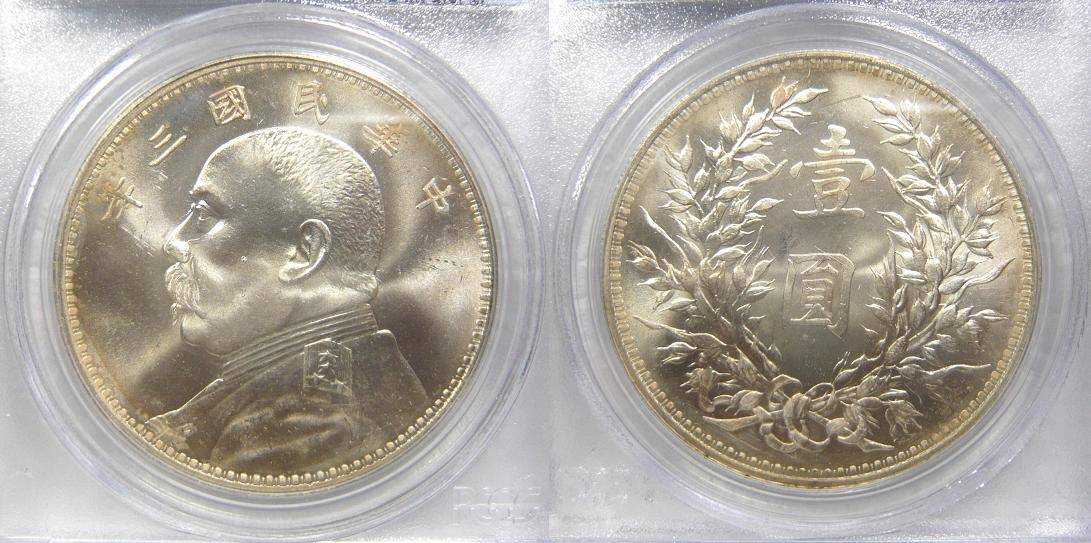
In this currency disaster, the hardest hit were China and India:
The purchasing power of silver in China plummeted by 78% within 30 years, leading to bankrupt merchants, ruined farmers, and the obliteration of private wealth, ultimately forcing the abolition of the silver standard in 1935 and the implementation of fiat currency reform;
The Indian rupee depreciated by 56% against the pound, equivalent to the colonial government's "blood transfusion" to the mother country, while the Indian people fell into poverty and debt.
"The Bitcoin Standard" emphasizes: the root cause of currency collapse is not price volatility but the loss of its "hardness." The softening of silver not only devoured the wealth of savers but also handed over two ancient civilizations to the iron heel of financial colonialism.
You may be worried that the currently soaring price of gold will be the next silver? The answer will be clearly provided later: yes.
1.5 Summary
From stone wheels to beads, from silver to paper currency, we discover a shocking pattern: all currencies, once issuance spirals out of control, their collapse is merely a matter of time.
What is truly consumed is not the currency itself, but human labor, time, and hope.
Currency is not just a medium of exchange; it is a bridge between people and the "future." If this bridge collapses overnight, the long-term planning, savings willingness, and social order of an entire civilization will also disintegrate.
Inflation is the invisible slaughter knife of civilization; scarcity is the lifeline of hard currency.
So, what is truly scarce in this world?
2. Scarcity is not Resources, but Time?
Why does money "devalue"? Why do all "high-inflation countries" throughout history end up in social turmoil? To unravel these puzzles, we must step outside the bank ledgers and interest rate curves to look at a more fundamental variable: scarcity.

Take gold as an example. Many people think "gold is valuable" because it is "too scarce." But did you know? The total amount of gold in the Earth's crust is about 60 trillion tons, theoretically allowing each person to have 8,000 tons.
What truly limits the supply of gold is not the Earth's resources themselves, but how much time humans spend mining it. On average, it takes processing 30 tons of ore and consuming 100 cubic meters of water to refine 1 ounce of gold, along with the use of large-scale machinery and skilled workers.
As Julian Simon said: the only real scarcity is the time invested in production.
In other words, gold is not "naturally scarce"; it is "artificially scarce." You seem to be storing value in gold, but in reality, you are relying on the credit of "others spending time mining." Once technological advancements break this mining threshold, the value support of gold will be precarious.
And this "technology → inflation" curse is not a hypothesis but the fate of history.
Looking back at history, almost every once-powerful currency—whether it be stone tools, copper coins, silver, or even fiat currency—has not escaped the same logical chain:
Technological advancement → Decreased mining costs → Supply surge → Inflation arrives → Trust collapses
For example, copper: between 1845 and 1873, copper prices plummeted by a full 80%. Not because no one needed copper, but because steam mining equipment became widely available, causing annual copper production to explode like a flood.
By the 21st century, deep-sea drilling technology even allowed humans to extract copper ore from 4,000 meters below the sea, theoretically expanding reserves by 1,000 times. The "currency status" of copper coins in history has thus vanished.
Therefore, any currency that relies on "physical scarcity" will enter a death spiral once technological breakthroughs occur.
Since we have already mentioned gold, let us use the above theory to predict the future of gold.
3. The Gold Dilemma: Crisis in the Era of Interstellar Mining
For the past two thousand years, humanity has used gold as the ultimate "hard currency," one important reason being that it is "difficult to mine." Unlike shells, paper currency, or glass beads, anyone can produce; it requires mines, labor, and equipment to be extracted bit by bit.
But have you ever thought about whether this logic can still hold in the space age?
3.1 Asteroid Mining: The Damocles Sword Approaching
NASA once estimated that an asteroid named "Psyche" (see the image below) may contain up to $70 trillion worth of metal resources—of which a significant portion is gold and platinum.
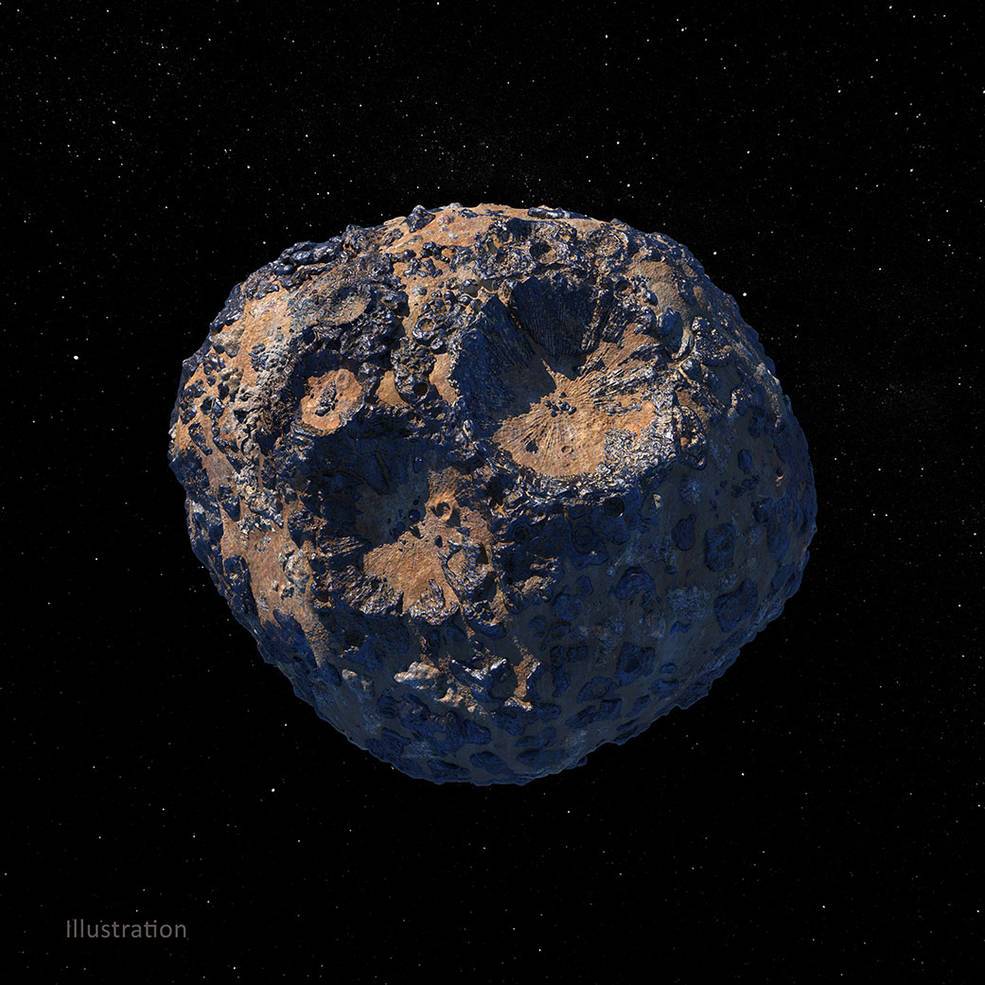
What does 70 trillion mean? It is equivalent to fifty times the current GDP of humanity, enough to buy all the countries, companies, and real estate on Earth.
More importantly, SpaceX's Starship program is pushing the cost of a rocket launch below $2 million. You heard that right, cheaper than a private jet. This means that once space mining technology matures, large quantities of metals can be transported back to Earth as easily as transporting vegetables.
Once gold becomes as readily available as iron, can it still maintain its status as a "store of value"? Of course not.
Currently, gold's Stock-to-Flow Ratio is about 56:1. What does this mean? It means that the total amount of gold above ground globally is approximately 200,000 tons, while the annual new production is around 3,500 tons, which is considered "controlled scarcity."
However, if by around 2070, humanity can transport 100,000 tons of gold back from space each year, this ratio could plummet from 56:1 to 2:1 or even lower.
Now you understand why Bitcoin likes to claim it is "harder than gold," right? Because the scarcity of gold could potentially be wiped out by technology within your lifetime.
So if gold can no longer rely on being "difficult to mine" to retain its value, is it possible for it to stabilize its price based on "demand"?
3.2 Nanotechnology: Turning Gold into a "Consumable"?
A gold investor might say: What’s there to fear? Even if we mine more, demand will rise accordingly.
This statement may not have held true in the past, but it could very well become a reality in the future—especially in the fields of nanotechnology and industrial catalysis.
As shown in the image below, the stability and catalytic activity of gold nanoparticles stem from their electric double-layer structure and surface potential distribution. This technological breakthrough is driving the growth of industrial gold demand. Gold is transitioning from a "store of value" to an "industrial consumable."
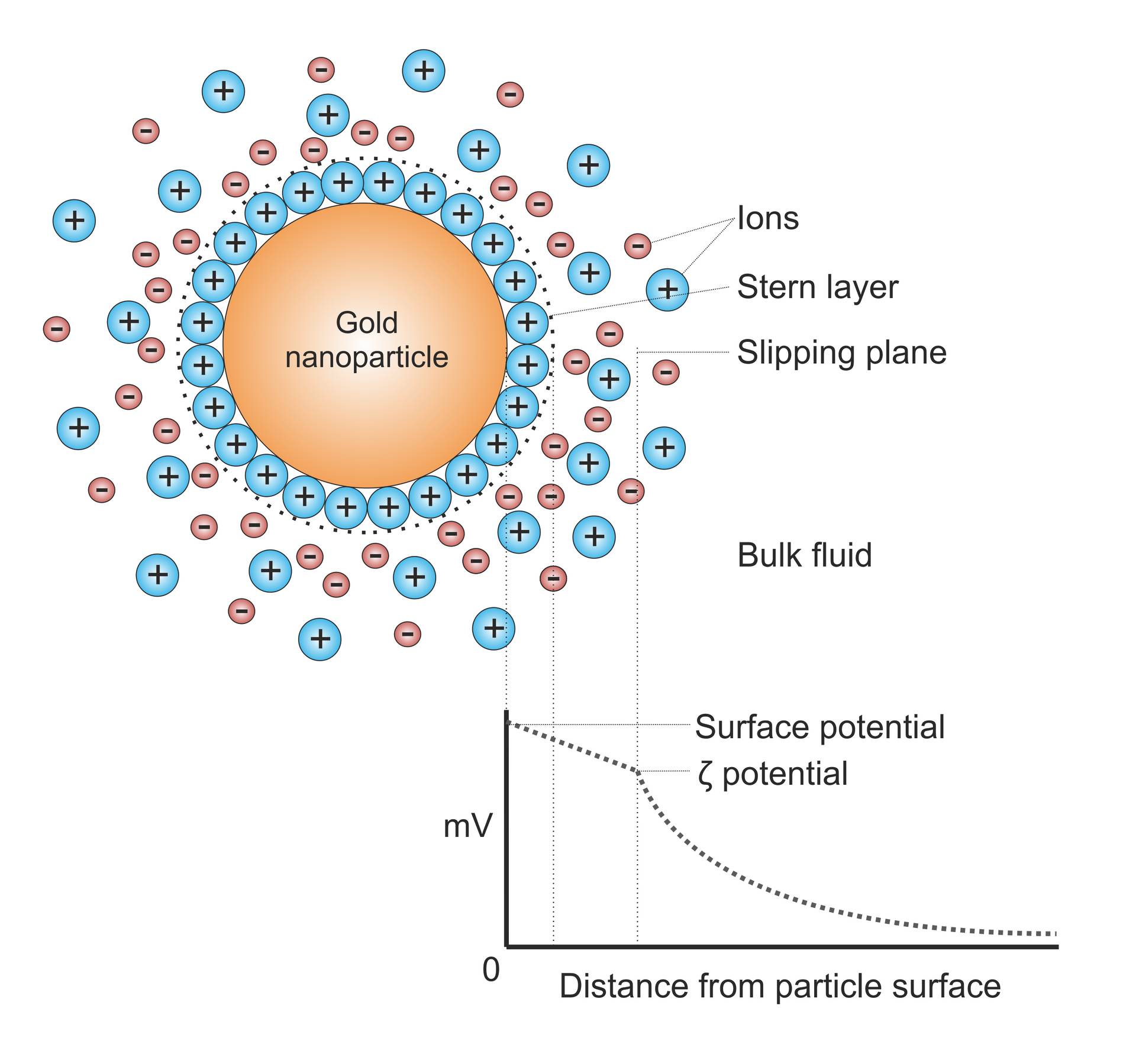
Currently, 1 gram of gold can be made into 500 square meters of nanocatalytic film, widely used in new energy, pharmaceuticals, and electronics manufacturing. Once this technology is widely adopted, global industrial demand for gold could surge from 4,500 tons to 12,000 tons, nearly tripling.
And once gold is "used" rather than quietly sitting in vaults like jewelry, it will truly become a "consumable"—which sounds like it would be better for its value, right?
Hold on, there’s another variable:
The recycling efficiency of industrial gold is explosively increasing.
For example:
- Gold used in electrocatalytic films;
- Gold turned into nanoparticles for drug delivery;
- Thin layers of gold used in chip manufacturing, sensors, and electrodes;
These are often fragmented, mixed, and buried deep within products, making past recycling costs extremely high and recovery rates very low, often resulting in them being "lost."

However, in recent years, with the application of micro-separation devices, new low-temperature solvents, and even microbial gold extraction technologies, the recycling efficiency of industrial gold is rapidly improving:
The recovery rate of gold in certain high-precision electronic devices has increased from less than 30% to over 90%;
The cost of extracting gold from old mobile phone circuit boards has decreased by 50%, becoming an important source for "urban mining";
In the future, "modular recycling stations" may even emerge to achieve rapid local gold extraction from industrial waste.
What does this mean?
The industrial gold that was originally thought to be "consumed" has not actually disappeared. It is just temporarily difficult to recover—and once the technology matures, it can continuously re-enter the market.
So, when you see industrial gold demand skyrocketing, don’t rush to conclude that "gold will become scarcer."
Because in the long run, this industrial gold is likely "borrowed," not "used up"—it may all be reclaimed and re-enter the supply.
At this point, you should understand that while the demand for industrial gold may expand, technology can accelerate both mining and recycling—double whammy.
Therefore, the decline in gold's Stock-to-Flow Ratio is a certainty; it’s just that this process is relatively slow. Moreover, the rate of gold depreciation will always be slower than that of fiat currency, so it appears that gold prices are still rising.
3.3 Geopolitics: Gold Reserves Aren't Really Yours
Unfortunately, there is another sword hanging over gold holders, which is geopolitical risk.
Do you know where the global central bank gold reserves are primarily located? In New York, USA. According to the Bank for International Settlements, about 60% of the official gold reserves globally (approximately 21,000 tons) are stored in the vaults of the New York Federal Reserve Bank, as shown in the image below.
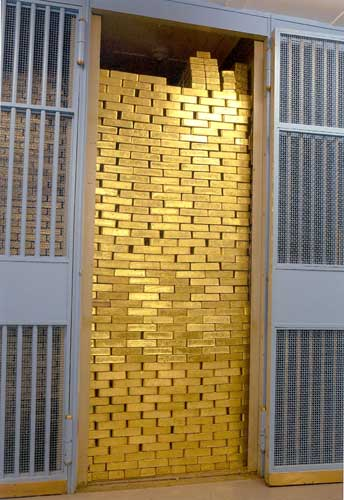
You heard that right; gold from Germany, the Netherlands, Japan, and even part of China's early gold is also "stored" in the Federal Reserve.
What does this mean? As long as geopolitical conflicts arise, the U.S. government could theoretically invoke the "Emergency Banking Act" to "freeze" other countries' gold reserves, just like in 1933.
This is no longer a "what if," but rather "what has happened." In 1971, Nixon closed the gold window, directly ending the Bretton Woods system, which you should not forget.
Gold may remain strong for a while, but with the continuous advancement of technology, it can no longer be the "forever trustworthy" safe haven.
Next, we will unveil the largest and most hidden currency trap currently: the U.S. dollar.
4. The Dollar Trap: The Collapsing Hegemony
What truly plunges the world into the quagmire of inflation is not stone money, not silver coins, not gold, but that name printed with "IN GOD WE TRUST"—the U.S. dollar. Note that the dollar is just a representation; others may be worse.
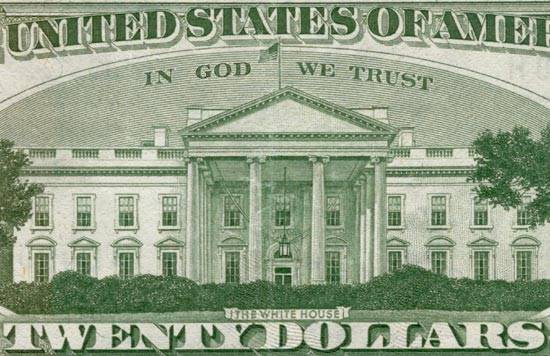
4.1 How Was Dollar Hegemony Forged?
In 1944, a "currency Yalta Conference" that would determine the fate of the world was held in Bretton Woods, New Hampshire, USA. Representatives from 44 countries signed an agreement that placed the anchor point of the global monetary system in the hands of the Americans.
The structure of this new system was simple yet extremely sophisticated:
Countries' currencies were pegged to the dollar;
The dollar was pegged to gold, fixed at $35 per ounce.
In other words, the dollar was not an ordinary fiat currency but a global super currency equivalent to gold. The U.S. leaped to become the "Pope of Currency," possessing the "divine right" to control the global value order.
Why did they dare to do this? Because at that time, the U.S. alone held 75% of the world's gold reserves (about 22,000 tons, as indicated by the arrow in the image below), while Europe was at war, Japan was in ruins, and China was in turmoil.
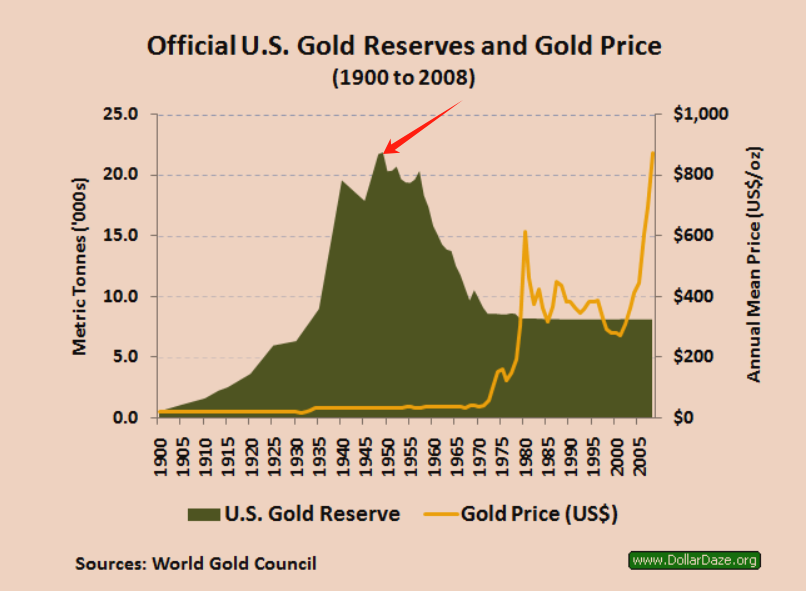
But how long could this "dollar equals gold" myth last?
It lasted less than 30 years.
By 1971, U.S. overseas military spending and welfare expenditures were increasing, while gold reserves were dwindling, with 60% of gold reserves lost in just twenty years.
Ultimately, Nixon issued an order: "The gold window is closed"—the dollar was decoupled from gold. The world completely entered the "fiat currency era," meaning that the paper currency in your hand was no longer pegged to anything, relying solely on one word: "trust."
From that year onward, the "floodgates" of inflation were completely opened.
In 1971, the total global base currency was only $480 billion;
By 2025, this number will grow to $200 trillion, an increase of 416 times.
Did you think the dollar was backed by "reserves"?
Wrong. Behind it are printing presses, national debt, and an increasingly worthless "future."
4.2 The Four Pillars of Dollar Hegemony
Many people think the dollar is strong because the U.S. economy is strong. This is true, but it is only the surface. What truly supports the global hegemony of the dollar are the four "financial pillars" it has built.
The first pillar is the petrodollar system.
In 1974, the U.S. reached a secret agreement with Saudi Arabia: global oil could only be priced in dollars. In other words, if the whole world wants to buy oil, it must first buy dollars.
This move turned energy into a "dollar necessity." As long as the Earth burns oil, the dollar will always be in demand. By 2025, global energy trade will reach $7.5 trillion, almost all of which will be "dollar liquidity."
The second pillar is the SWIFT settlement system.
SWIFT covers 200 countries and 11,000 financial institutions, making it the largest cross-border payment network in the world. The core servers of this system are in Belgium—but the control is in Washington.
In other words, the U.S. government has the authority to "block" any country's cross-border transfers. This is not speculation; it is reality. Iran, Russia, and Afghanistan have all been kicked out of SWIFT during critical periods, freezing global funds.
The third pillar is the U.S. debt pool.
The amount of U.S. Treasury bonds held by global central banks once reached $7.5 trillion, accounting for 59% of global foreign exchange reserves. This is like a collective "dollar insurance" purchased by global central banks.
What’s more frightening is: the more people buy U.S. debt, the more the U.S. dares to borrow, the more the dollar floods, and the harder it becomes for you to exit.
The fourth pillar is the more than 1,000 U.S. military bases worldwide.
In 2023, U.S. military spending reached $916 billion, exceeding the total of the next 11 countries combined. Do you think this is geopolitical security? No, it is actually the "military collateral for the dollar."
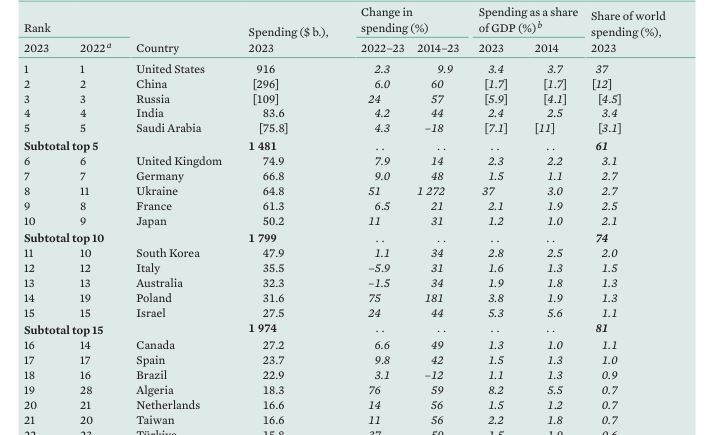
With these four pillars supporting it, dollar hegemony locks the global economy in a maze; you know the direction but have no way to escape.
However, now, it is starting to crack.
4.3 Two Major Cracks: Ripping Apart the Dollar's Divine Robe
Once, the dollar was clad in four layers of armor—oil, SWIFT, U.S. debt, and the military—unassailable. But now, this shiny divine robe is being torn apart from two directions simultaneously.
The first crack: Debt addiction is rotting from within.
As of early 2025, the total federal government debt of the U.S. has surpassed $36 trillion, equivalent to 127% of GDP. Just the interest payments will exceed $952 billion, nearly matching the military budget and approaching the total of education and healthcare expenditures.
Moreover, this debt clock is ticking up by $40,000 every second. The Congressional Budget Office predicts that by 2052, for every $3 the U.S. government collects in taxes, it will have to pay $1 in interest.
This is not debt management; it is drinking poison to quench thirst, a national-level Ponzi scheme. When interest consumes the budget and deficits become the norm, how much credit does the dollar have left?
The second crack: The wave of de-dollarization is stirring up external storms.
Once upon a time, global central banks regarded the dollar as the "last anchor." In 2000, 70% of global foreign exchange reserves were in dollars. But by the third quarter of 2024, this proportion had fallen below 58% and continues to decline.
In 2023 alone, China reduced its holdings of U.S. Treasury bonds by $100.4 billion; countries like Saudi Arabia, Brazil, and India are also promoting local currency settlements to bypass the dollar.
At the same time, cryptocurrencies are rising as a "financial neutral zone." By early 2025, the total market capitalization of cryptocurrencies surpassed $2.8 trillion, with more and more countries, businesses, and individuals beginning to use them to evade the dollar-dominated sanctions and settlement system.
This wave of de-dollarization is no longer just geopolitical confrontation; it is a triple play of technological revolution + financial decoupling + sovereign awakening.
When the use of the dollar is "forced," rather than being "chosen by trust," its hegemony has already begun to unravel.
4.4 Summary: The Self-Contradiction of Dollar Hegemony
Since decoupling from gold in 1971, the dollar has embarked on a paradoxical path:
To be the global currency, it must "flood" the world; but the more it floods, the more its credit is diluted, undermining its hegemonic status.
This is the essence of the "Triffin Paradox": to maintain its status as a reserve currency, the dollar must be exported; but the more it is exported, the faster it collapses.
Countries around the world see the end of this game, yet no one dares to leave first—because the dollar is not a better choice, but the only choice.
Until now, we have finally begun to ask:
Is there a currency that does not rely on power for support, does not rely on trust for maintenance, and operates solely on code and mathematics?
Is there a currency that can completely end this cycle of inflation?
5. Bitcoin Breakthrough: A New Monetary Paradigm Under Mathematical Tyranny
We have unveiled the "future dilemma" of gold and seen the "systemic cracks" of dollar hegemony. At this point, you may ask: Bitcoin, without the protection of an army and without the endorsement of a state, how can it break through relying solely on code and computing power?
Let’s analyze this one by one.
5.1 The Code Seal of Absolute Scarcity
There will only ever be a maximum of 21 million bitcoins in the world. This is not a "theoretical limit," but a physical reality written into the code.
It uses a cryptographic algorithm called SHA-256, producing one block every 10 minutes, with the bitcoin reward in each block halving every four years until it approaches zero.
What does this mean?
It means that even if there were 1,000 Federal Reserves and 100 million mining machines on Earth, it would still be impossible to create the 21,000,001st bitcoin. For the first time in the world, there is a currency whose "issuance speed" is unrelated to human greed and is only tied to time itself. Thus, we say that Bitcoin is the first time-anchored currency in human history.
5.2 The Security Wall Against Quantum Attacks
Many people worry: Will quantum computing make Bitcoin "obsolete"? Can it crack private keys and take over the entire chain?
This question has been discussed in the tech community for over a decade, and the answer is quite clear: First, the security foundation of Bitcoin is not a single person but the "collective verification" of the entire network. Even if quantum computing can crack private keys, as long as that coin has not been used, everyone will automatically reject that transaction.
Secondly, the Bitcoin community has long been prepared with "quantum-level upgrade" solutions, including Lamport signature algorithms, multi-signature protection, and key rotation mechanisms.
More critically: To alter Bitcoin through a "hash power attack," an attacker must simultaneously control over 50% of the global mining power.
As of February 2025, the total hash rate of the Bitcoin network has reached 954.16 EH/s, executing 95.4 quintillion cryptographic operations per second, as shown in the image below.
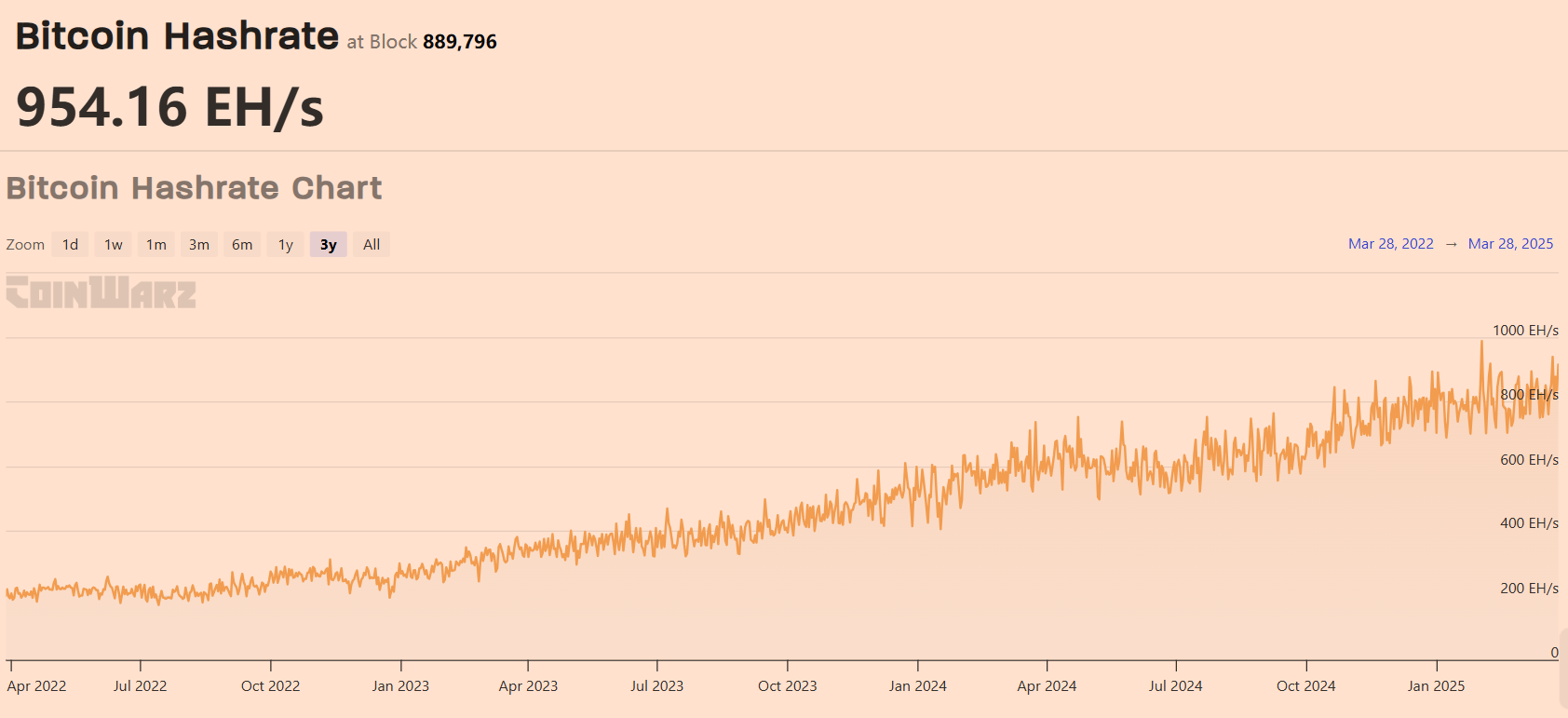
To launch a 51% attack, an attacker would need to assemble a hash power system exceeding 477 EH/s.
What does this mean? Even if you combined all the supercomputers in the world, they would not be able to execute even a small fraction of such specialized hash tasks. This is because the Bitcoin network relies on thousands of dedicated mining machines (ASICs), each capable of executing trillions of SHA-256 operations per second.
So, Bitcoin is not invincible, but it is strong enough—strong enough that you don’t even need to trust it for it to operate effectively.
5.3 The Immortal Gene of a Distributed Network
You may remember that when Russia was deprived of SWIFT access, its banking system nearly came to a halt. You may also recall that when the Afghan regime changed, all dollar accounts were frozen, and overnight, the treasury became an empty shell.
The design of Bitcoin is meant to address these "central collapse" issues. It is decentralized, with no headquarters, no switches, and no one person in charge. There are over 21,600 nodes distributed across more than 100 countries; the mainnet code is open source, allowing anyone to verify, replicate, and disseminate it.
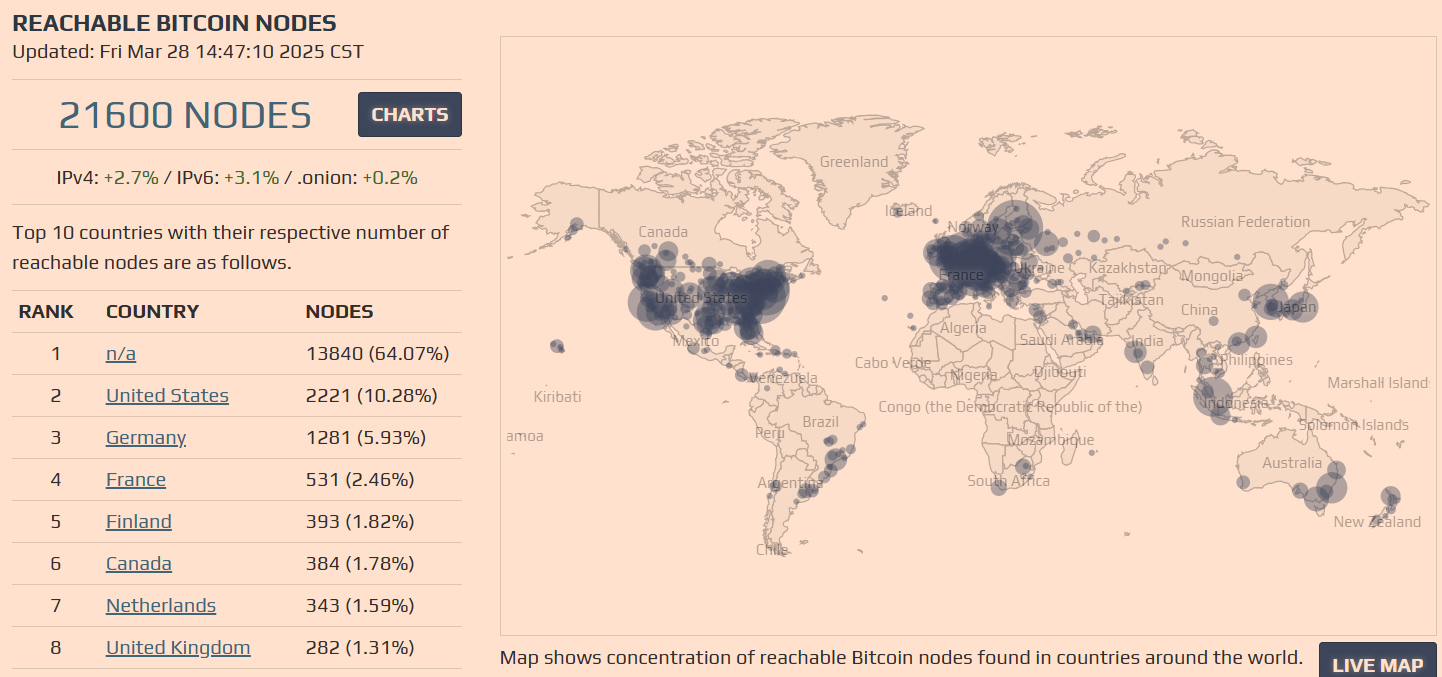
You say it is not a currency? Perhaps it is more like a living organism, a "free entity" existing between the internet and time.
It does not need an army for protection, nor does it need a bank for custody. It only requires you to remember a string of private keys to control all your wealth anytime, anywhere.
5.4 The Time Machine That Activates the Will to Save
High inflation can make people shortsighted; money today is worth less tomorrow, so why not spend it now?
Bitcoin, on the other hand, is the opposite. Because it is deflationary, because it is scarce, and because it has no owner, it inspires a very rare emotion: the willingness to wait. A holder of Bitcoin often chooses to "hold long-term," like planting a seed and waiting for it to sprout slowly. Data shows that over 65% of Bitcoin has not moved for more than a year, with many addresses remaining inactive for even "10 years."
This is precisely Bitcoin's greatest strength: it is not an investment product; it is a storage vessel for value, a reverser of time preference.
5.5 Summary: Bitcoin is Not the Answer, But the Starting Point
Bitcoin is not perfect. Its price is highly volatile, technology is still evolving, and the system is not yet mature. But it has at least achieved the closest outline of an "ideal currency" in human history:
- Its total supply is immutable and not subject to the will of power;
- It has no issuer and no confiscator;
- It cannot be artificially inflated, nor will it vanish with wars and regimes;
- It can be carried anywhere, circulate globally, without permission or trust;
- It is not built on "national credit," but on "mathematics and consensus."
From the stone wheels of Yap Island, African glass beads, the silver storm, to dollar hegemony, we have repeatedly placed our hopes on power and trust, only to witness their collapse time and again.
And Bitcoin is the first time we have entrusted the foundation of currency to code, time, and transparent rules.
Conclusion
True scarcity has never been metals, paper money, or gold reserves, but the time we can freely allocate.
Bitcoin is not perfect, but it at least offers a possibility:
A currency that does not rely on government, does not rely on trust, but solely on rules and transparent time consensus.
As we live in an era where inflation is beautified, debt is indulged, and wealth is silently plundered, we need not only the courage to combat the currency trap but also a monetary philosophy that aligns with time.
This is the core proposition of "Bitcoin Standard":
Return to a time-based standard, escape the currency trap.
This revolution in economic order may have only just begun.
And we are the witnesses, and possibly the choosers.
免责声明:本文章仅代表作者个人观点,不代表本平台的立场和观点。本文章仅供信息分享,不构成对任何人的任何投资建议。用户与作者之间的任何争议,与本平台无关。如网页中刊载的文章或图片涉及侵权,请提供相关的权利证明和身份证明发送邮件到support@aicoin.com,本平台相关工作人员将会进行核查。




